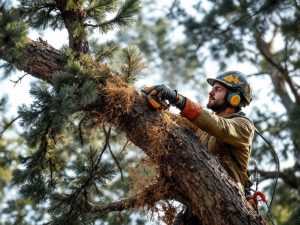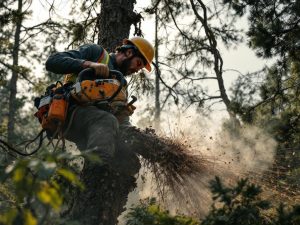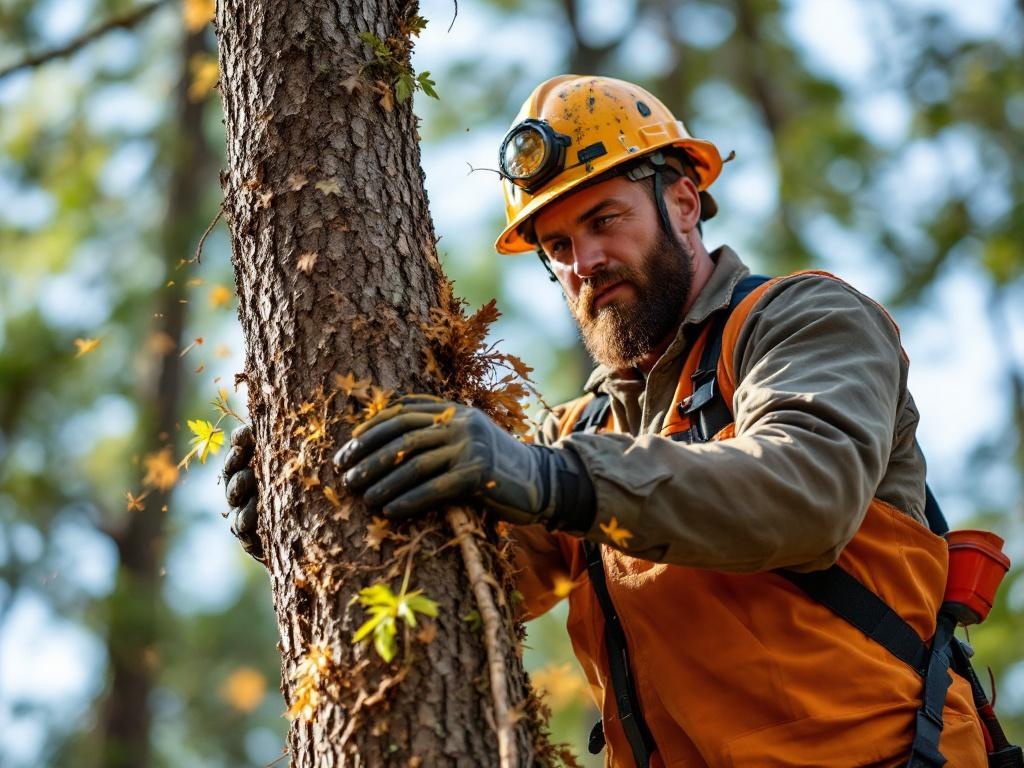Emergency Tree Removal: Recognizing Hazards and When to Act Fast in Colorado
In Colorado, it’s absolutely crucial to recognize potential tree hazards quickly and understand when emergency tree removal in Colorado might be necessary. Indeed, vigilant observation for signs like dead limbs, significant cracks in the trunk, or a tree leaning precariously can lead to serious safety risks for your property and loved ones.
Severe weather events, such as heavy snowfalls, ice storms, or powerful high winds, can regrettably worsen the instability of already compromised trees, escalating their danger. If you spot any of these warning signs, do not hesitate to act fast and consider promptly calling a professional for emergency tree removalin Colorado.
Knowing precisely when to act is imperative for your safety and the preservation of your property, and there’s more important information ahead to guide your decisions regarding emergency tree removal in Colorado.
Understanding the Risks: Common Tree Hazards in Colorado

What precise dangers do trees pose in your Colorado home landscape? You might not immediately realize that even seemingly healthy trees can become significant hazards, especially during severe storms or periods of high winds. Indeed, understanding these common tree hazards is the first step in proactive emergency tree removal in Colorado preparedness.
Dead or dying trees, for instance, often have brittle branches that can snap off unexpectedly, posing direct risks to nearby structures, vehicles, and, most critically, people.
Furthermore, trees weakened by insidious pests or diseases can fall unpredictably, creating an extremely dangerous situation without warning. Beyond the canopy, tree roots can also cause significant problems; they can undermine sidewalks, driveways, and even home foundations, leading to tripping hazards, costly structural damage, or compromised underground utility lines.
Moreover, in fire-prone regions of Colorado, trees located too close to homes can act as fuel ladders, dramatically increasing wildfire risk. In snowy conditions, heavy accumulation of snow and ice on branches can cause them to snap, leading to injuries or extensive property damage.
Ultimately, understanding these diverse risks is vital for maintaining comprehensive safety in your environment, making it absolutely essential to regularly assess the trees around you for any signs of danger that might necessitate emergency tree removalin Colorado.
Identifying Warning Signs of a Dangerous Tree
As you diligently assess the trees around your property, knowing how to spot key warning signs that indicate potential danger is crucial for preemptive emergency tree removalin Colorado. Indeed, early identification can prevent significant damage or injury.
- Dead or Dying Branches: Meticulously check for branches that are brittle, discolored, or show no signs of life, especially in summer. If they are easily breakable or devoid of leaves when other branches are green, they could fall unexpectedly.
- Trunk Cracks, Splits, or Wounds: Inspect the main trunk for any deep cracks, significant splits, or large, open wounds. These can severely compromise the tree’s stability and overall structural integrity, making it highly susceptible to failure.
- Leaning Trees: A tree that suddenly starts leaning or appears off-balance, especially if the lean is pronounced or rapidly worsening, can signal significant root damage or instability. Look for soil heaving around the base.
- Fungal Growth (Conks/Mushrooms): Watch for fungal growth (mushrooms or conks) at the base of the tree or along the trunk. These fungi often indicate internal decay and rot within the tree’s wood, weakening its core structure.
- Excessive Leaf Loss or Discoloration: While seasonal leaf drop is normal, excessive or unusual leaf loss, or sudden discoloration outside of autumn, could be a sign of severe stress, disease, or pest infestation impacting the tree’s health.
- Pest Infestation: Look for signs of insect boring, sawdust-like frass, or unusual holes in the bark, indicating a potentially damaging pest infestation that could compromise the tree’s strength.
Trust your instincts: if a tree looks threatening or displays multiple warning signs, it’s unequivocally best to consult a professional arborist for further evaluation and potential emergency tree removalin Colorado.
The Impact of Severe Weather on Tree Health
Severe weather events can profoundly impact the health and structural integrity of your trees, often leading to damage that isn’t immediately visible. Understanding these cumulative effects is vital for effective emergency tree removal assessment and prevention.
- High Winds: Strong winds can cause extensive damage, ranging from breaking off individual branches to completely uprooting entire trees. Even if a tree doesn’t fall, hidden internal cracks or root tears can occur, making it unstable for future storms.
- Heavy Snow and Ice: The accumulated weight of heavy snow and ice on branches can lead to severe stress, causing limbs to split, crack, or even snap off entirely, potentially damaging property or power lines below. Additionally, ice can cause tree bark to crack and peel, making them susceptible to disease.
- Drought Conditions: Prolonged drought may weaken your trees, making them more susceptible to pests and diseases by reducing their natural defenses. Consequently, weakened trees are much more prone to breaking or falling during even moderate wind events.
- Lightning Strikes: Direct lightning strikes can cause immediate and catastrophic damage, including splintering trunks or igniting fires. Even nearby strikes can damage root systems.
- Flooding: While less common for established trees, prolonged saturation of roots from localized flooding can suffocate the root system, leading to decay and eventual tree death or instability.
Regular post-storm inspection is crucial to identify and address damage early, often necessitating emergency tree removal for compromised trees.
Assessing Tree Stability and Structural Integrity: When to Consider Emergency Tree Removal
How can you confidently guarantee your trees remain safe and stable after severe weather events, or simply over time? Assessing their stability and structural integrity is paramount for preventing accidents and informing emergency tree removal decisions.
- Inspect for Trunk Cracks and Leaning: Meticulously look for any new or widening cracks in the tree’s trunk, especially those extending deep into the wood. A sudden or pronounced lean in a tree, particularly if it was previously straight, can indicate significant root damage or soil instability.
- Exposed or Heaving Roots: Check the ground around the base of the tree for exposed, severed, or heaving roots. This is a clear sign that the root system, which anchors the tree, is compromised, greatly increasing the risk of the tree falling.
- Large, Dead, or Hanging Branches: Identify any large, dead, or visibly broken branches (called “widowmakers”) that are hanging precariously in the canopy. These pose an immediate threat and require urgent attention, often falling during the next wind event.
- Soil Erosion or Saturation: Assess the soil around the base; if it’s severely eroded, excessively saturated, or shows signs of recent disturbance, your tree’s stability might be compromised. This is particularly crucial after heavy rainfall or flooding.
- Decay or Cavities: Look for signs of extensive decay, soft spots, or large cavities in the trunk or major limbs. These indicate that the internal wood structure is weakening, making the tree unstable.
- Evaluate Nearby Trees for Competition: If your trees are growing too closely together, they might be competing for resources, leading to weaker growth patterns or intertwined roots that could compromise stability.
- Species and Age Consideration: Understand that some tree species are naturally more susceptible to damage (e.g., fast-growing, brittle wood types), and very old trees may have inherent weaknesses.
Regular assessments by a qualified arborist will help you maintain a safe environment around your property and guide timely emergency tree removalin Colorado if necessary.
When to Call for Professional Emergency Tree Removal Help

When should you unequivocally reach out to a professional for emergency tree removalin Colorado? If you’re ever unsure about the safety of a tree on your property, it’s always best to call in the experts without delay. Indeed, attempting DIY removal of a dangerous tree can be extremely hazardous.
Here are some critical situations where professional emergency tree removalin Colorado help is absolutely essential:
- Trees Leaning Dangerously: If a tree is leaning considerably towards your home, another structure, a power line, or a public area, or if it shows signs of uprooting (e.g., raised soil on one side), it poses an immediate and severe risk to your property and safety.
- After Severe Storm Damage: Following a major storm, even if a tree hasn’t completely fallen, inspect for large broken branches, deep splits in the trunk, or partial uprooting. These “hidden” damages can lead to catastrophic failure later, necessitating professional assessment and
emergency tree removal. - Presence of Large Dead or Diseased Limbs Over Structures: If large, dead, or visibly diseased limbs are directly overhanging your house, garage, or frequently used outdoor areas, they are a significant liability and should be professionally removed.
- Signs of Extensive Decay or Cavities: If you notice extensive fungal growth, large hollows, or soft, crumbling wood on the trunk or major branches, the tree’s internal structure is compromised, making it highly prone to sudden failure.
- Tree Near Power Lines: Never attempt to prune or remove a tree that is close to or touching power lines. This is extremely dangerous and should only be handled by certified professionals with specialized equipment, often in coordination with the utility company.
- You Lack Proper Equipment or Experience:
Emergency tree removalin Colorado involves heavy equipment, chainsaws, ropes, and a deep understanding of tree mechanics. Without the right tools and expertise, it’s incredibly dangerous for an untrained individual.
Don’t hesitate to seek immediate professional help in these scenarios; addressing these issues promptly can prevent costly damage, severe injuries, and ensure your absolute safety.
Emergency Tree Removal Procedures: What to Expect
In critical situations where a tree poses an immediate threat, understanding the emergency tree removal in Colorado procedures can make all the difference in a safe and efficient resolution. When you contact a professional emergency tree removalin Colorado service, here’s generally what you can expect:
- Immediate Risk Assessment: Upon arrival, the professional team will first conduct a rapid, thorough assessment of the situation. They will determine the level of immediate risk to people, structures, and utilities, prioritizing safety above all else.
- Area Securing and Containment: If it’s safe to do so, they will immediately cordon off the danger zone using caution tape or barriers to prevent anyone from entering the hazardous area. This minimizes the risk of injuries from falling debris during the
emergency tree removalprocess. - Specialized Equipment and Planning: The team will arrive with specialized heavy equipment, such as cranes, lifts, chippers, chainsaws, and rigging gear. They will then formulate a precise plan for safe removal, taking into account the tree’s lean, surrounding obstacles, and potential fall zones.
- Safe Disassembly/Removal: Depending on the situation, the tree might be taken down in sections, often using ropes and rigging to lower large limbs safely. In some cases, a crane may be used to lift entire sections over structures. Their techniques are designed to control the fall and minimize further damage.
- Debris Cleanup: After the hazardous portion of the tree is removed, they will proceed with debris cleanup, chipping branches, and hauling away larger logs. They aim to leave the site as clean and safe as possible.
- Stump Grinding (Optional): If requested, they can also perform stump grinding to remove the remaining tree stump below ground level.
- Documentation for Insurance: The professionals can also provide documentation of the incident, photos, and invoices, which are crucial for your insurance claim.
Following their instructions is essential for your safety and the efficient completion of the emergency tree removalin Colorado.
Preventative Measures to Protect Your Property from Tree Hazards
While you can’t control the weather’s intensity, taking proactive preventative measures can significantly reduce the risk of tree-related damage to your property and minimize the need for emergency tree removalin Colorado. Indeed, diligent foresight is your best defense.
- Regular Tree Inspections: Consistently schedule professional tree inspections by a certified arborist, ideally annually. They can identify early signs of weakness, disease, decay, or structural issues that you might miss, allowing for timely intervention.
- Strategic Pruning: Implement
tree pruning best practices. Regularly trim dead, diseased, or overhanging branches, especially those directly over your home, garage, or frequently used areas. Proper pruning reduces the chance of them falling during storms and promotes overall tree health. - Maintain Root Health: Ensure your trees have healthy, stable root systems by avoiding soil compaction around their base (e.g., from heavy machinery or vehicles), maintaining proper watering, and avoiding excessive soil disturbance. Healthy roots provide strong anchorage.
- Consider Tree Selection: When planting new trees, choose species that are well-suited to Colorado’s climate, have strong root systems, and are less prone to breaking in high winds or under heavy snow.
- Clearance from Structures: Maintain adequate clearance between trees and your home, power lines, and other structures. This prevents branches from rubbing or causing damage, and reduces fire risk.
- Cabling and Bracing: For valuable trees with weak or splitting crotches, a professional arborist can install cables or braces to provide additional structural support, reducing the risk of failure.
- Post-Storm Assessment: After any severe weather, conduct a careful visual inspection of all your trees for new damage, even if it seems minor. Hidden damage can become a major problem later.
By implementing these preventative measures, you can significantly protect your home, enhance your property’s safety, and reduce the likelihood of needing costly emergency tree removal.
In conclusion, in Colorado’s dynamic environment, being acutely aware of tree hazards and understanding when emergency tree removal is necessary can quite literally save your property, and potentially, lives. By vigilantly recognizing early warning signs of a dangerous tree—from dead limbs to trunk cracks and precarious leans—you empower yourself to act decisively. Indeed, severe weather can dramatically worsen tree health, so consistently keeping a keen eye on your landscape, especially after storms, is paramount.
Crucially, when in doubt about a tree’s stability or structural integrity, do not hesitate to call in a professional arborist. Ultimately, by integrating these proactive preventative measures, understanding the nuances of emergency tree removal in Colorado procedures, and always prioritizing safety, you can robustly protect your home, ensuring that you and your family can safely enjoy the beauty of Colorado’s trees without the inherent risks.
Stay safe out there by staying informed and prepared for emergency tree removalin Colorado or contact Above and Beyond for Professional Emergency Tree Removal.
Key Takeaways: Recognizing Hazards and When to Act Fast for Emergency Tree Removal
- Immediate Hazard Identification: Diligently identify dead or dying branches, significant cracks, or noticeably leaning trees as immediate hazards that may unequivocally require
emergency tree removalin Colorado. - Disease & Instability Indicators: Monitor for subtle signs of fungal growth, pest infestations, or excessive leaf loss, as these often indicate potential tree instability or underlying disease.
- Post-Weather Inspection: After severe weather events, meticulously inspect trees for hidden damage, as high winds and heavy snow can compromise their structural integrity, necessitating
emergency tree removalin Colorado. - Prompt Professional Contact: If a tree poses an immediate risk to people or property, swiftly cordon off the area and contact a professional
emergency tree removalservice without delay. - Documentation for Claims: Document hazardous trees and their precise conditions with clear photos and videos for insurance purposes, ensuring you have robust evidence of the situation for potential claims related to
emergency tree removalin Colorado.




